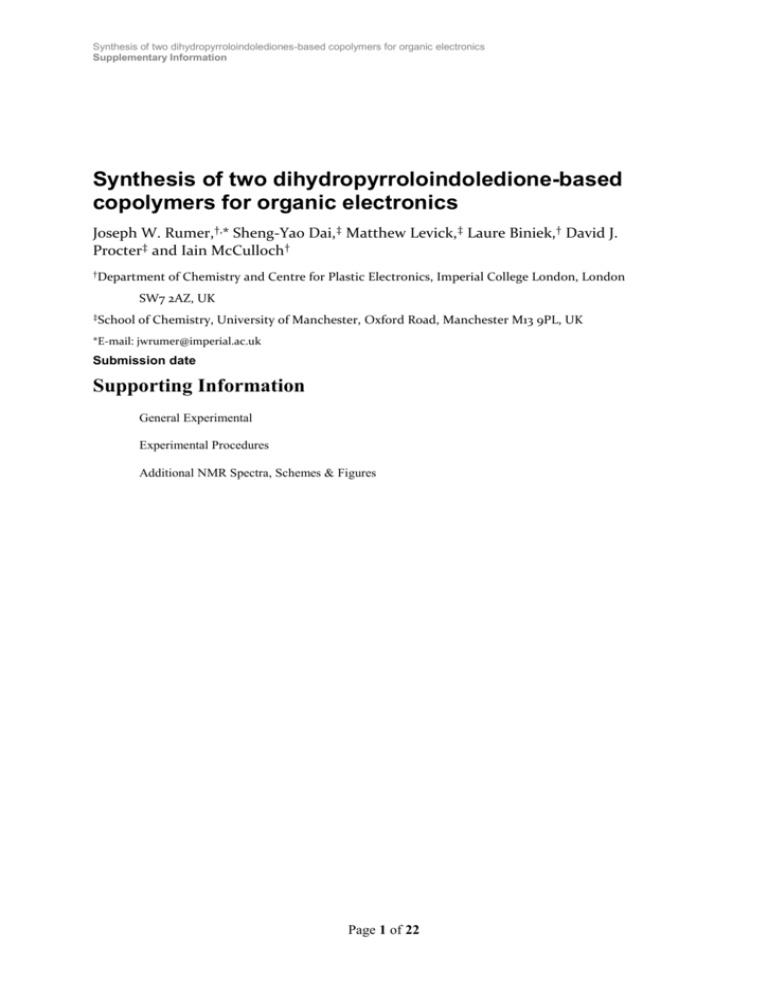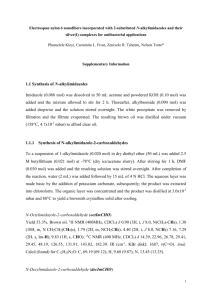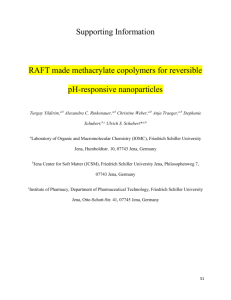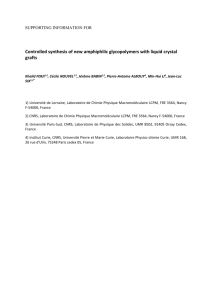POLA_26471_sm_SuppInfo
advertisement

Synthesis of two dihydropyrroloindolediones-based copolymers for organic electronics Supplementary Information Synthesis of two dihydropyrroloindoledione-based copolymers for organic electronics Joseph W. Rumer,†,* Sheng-Yao Dai,‡ Matthew Levick,‡ Laure Biniek,† David J. Procter‡ and Iain McCulloch† † Department of Chemistry and Centre for Plastic Electronics, Imperial College London, London SW7 2AZ, UK ‡ School of Chemistry, University of Manchester, Oxford Road, Manchester M13 9PL, UK *E-mail: jwrumer@imperial.ac.uk Submission date Supporting Information General Experimental Experimental Procedures Additional NMR Spectra, Schemes & Figures Page 1 of 22 Synthesis of two dihydropyrroloindolediones-based copolymers for organic electronics Supplementary Information General experimental Instrumental NMR spectra were recorded on a Bruker DPX0 400 MHz spectrometer using an internal deuterium lock at ambient probe temperatures unless stated otherwise. Chemical shifts (δ) are quoted in ppm relative to the solvent residual peak, with peak multiplicity (bs, broad singlet; s, singlet; d, doublet; t, triplet; q, quartet; m, multiplet), integration and coupling constants (J) quoted in Hz (uncorrected) as appropriate. CDCl3 was used as the solvent for all spectra unless stated otherwise. Proton solvent residual peaks are taken as: 7.26 for CDCl3, 7.15 for C6D6, 3.34 for methanol-d4, 2.52 for DMSO-d6; and carbon solvent residual peaks as: 77.16 for CDCl3, 128.6 for C6D6, 49.9 for methanol-d4, 39.7 for DMSO-d6. Mass spectra were recorded by the Imperial College London Department of Chemistry Mass Spectrometry Service on a Micromass Platform II or AutoSpec-Q spectrometer. UV-Vis detection was performed using a UV-1601 Shimadzu UV-Vis spectrometer. Molecular weights (Numberaverage [Mn] and weight-average [Mw]) were recorded on an Agilent Technologies 1200 series GPC in chlorobenzene at 80°C, using two PL mixed B columns in series, calibrated against narrow polydispersity polystyrene standards. Cyclic voltammetry (CV) was performed under an argon atmosphere in a three-electrode electrochemical cell at a potential scan rate of 50 mVs-1. Thin-films of the polymers were spin-coated (from chlorobenzene solution, 5 mg/mL) on conducting indium tin oxide (ITO) glass substrates and used with a platinum mesh counter electrode, Ag/Ag+ reference calibrated against ferrocene and n Bu4NPF6 as the electrolyte in anhydrous acetonitrile solution (0.1M). Microwave chemistry was performed in a Biotage initiator v.2.3. Infrared spectra were recorded using an FTIR spectrometer as evaporated films or neat using sodium chloride windows. Melting points are uncorrected. Experimental procedures Detailed experimental procedures are described below. All solvents, reagents and other chemicals were used as received from commercial sources, or purified using standard procedures unless stated otherwise. The use of anhydrous chemicals, intuitive from the reaction, infers anhydrous conditions under an argon or nitrogen atmosphere. Glassware for inert atmosphere reactions was oven dried and cooled under a flow of nitrogen. All temperatures – other than room temperature – are recorded as bath temperatures of the reaction, unless stated otherwise. Merck aluminium backed precoated silica gel (50 F254) Page 2 of 22 Synthesis of two dihydropyrroloindolediones-based copolymers for organic electronics Supplementary Information plates were used for thin-layer chromatography (TLC). Visualisation was by ultraviolet light (254 nm) and/or either potassium permanganate(VII), vanillin, iodine or Molybdate staining with heating as appropriate. Column chromatography was performed on Merck silia gel (Merck 9385 Kieselgel 60, 230-400 mesh) under a positive air pressure using reagent or GRP grade solvent as received. PE refers to petroleum spirit 60-80 °C; Hex refers to hexane. THF was freshly distilled from sodium/benzophenone. For SmI2-mediated reactions, freshly distilled THF was further deoxygenated prior to use by bubbling with nitrogen gas for 30 min.CH2Cl2 and Et3N were freshly distilled from CaH2. All other solvents and reagents were purchased from commercial sources and used as supplied Samarium diiodide was prepared by a modification of the procedure of Imamoto and Ono.1 Samarium powder (2.00g, 13.8 mmol, 1.2 eq.) was added to an oven-dried round-bottomed flask and the flask was sealed and flushed with nitrogen gas for 20 min. THF (110 mL) was added and the resulting suspension was bubbled with nitrogen gas for 15 min. Finally, iodine (2.80 g, 10.8 mmol, 1.0 eq.) was added and the flask flushed again with nitrogen gas for 10 min. The flask was covered in aluminium foil and heated at 60 °C for 18 hours. The approx 0.1 M solution was allowed to cool to room temperature and then used directly. 1 T. Imamoto, M. Ono, Chem. Lett. 1987, 501 Page 3 of 22 Synthesis of two dihydropyrroloindolediones-based copolymers for organic electronics Supplementary Information Experimental procedures 2-octyldodecanoic acid To MeCN (850 mL) was added H5IO6 (53.5 g, 0.235 mol) and the mixture was stirred vigorously at room temperature for 15 min. 2-octyldodecan-1-ol (31.8 g, 0.107 mol) was then added at 0 °C followed by addition of PCC (460 mg, 2 mol%) in MeCN (2 × 50 mL) and the reaction mixture was stirred for overnight. The reaction mixture was then diluted with EtOAc and washed with aq. NaHCO3 solution and brine, respectively, dried (MgSO4) and concentrated in vacuo to give the clean carboxylic acid (33.3 g, 99 %). 1H NMR (400MHz, CDCl3), (ppm): 0.89 (t, J = 6.8 Hz, CH3, 6H), 1.26- 1.32 (m, CH2, 28H), 1.49 (m, CHCH2, 2H), 1.62 (m, CHCH2, 2H), 2.35 (m, CH, 1H). C NMR (100MHz, CDCl3), (ppm): 14.1 (2 13 CH3), 22.68, 22.70, 27.4, 29.28, 29.36, 29.44, 29.59, 29.63, 31.88, 31.93, 32.18 (16 CH2), 45.6 (CH), 183.2 (C=O). IR (ATR): νmax/(cm-1): 2954, 2913, 2850, 1696, 1471, 1229, 1220, 953, 716. MS (ES+): m/z (%): 335 (100, [M+Na]+), 349 (80), 392 (40); HRMS (ES+): C20H40O2Na requires 335.2921, found 335.2917. Page 4 of 22 Synthesis of two dihydropyrroloindolediones-based copolymers for organic electronics Supplementary Information 1 H NMR (400MHz, CDCl3) H.esp 1.00 10.0 9.5 9.0 8.5 8.0 7.5 7.0 6.5 6.0 5.5 5.0 4.5 Chemical Shift (ppm) 4.0 3.5 3.0 2.5 1.99 1.97 27.98 6.02 2.0 1.5 1.0 0.5 0 13 C NMR (100MHz, CDCl3) C.esp 200 192 184 176 168 160 152 144 136 128 120 112 104 96 88 Chemical Shift (ppm) Page 5 of 22 80 72 64 56 48 40 32 24 16 8 0 Synthesis of two dihydropyrroloindolediones-based copolymers for organic electronics Supplementary Information N,N'-(1,4-phenylene)bis(2-octyldodecanamide) (2) To a solution of 2-octyldodecanoic acid (33.3 g, 0.108 mol) in CH2Cl2 (200 ml) was added SOCl2 (14.0 g, 0.117 mol) slowly at 0 °C and the mixture was stirred at room temperature overnight. The mixture was concentrated in vacuo to afford 2-octyldodecanoyl chloride which was used without further purification (crude = 35.3 g). To a stirring solution of p-phenylenediamine (5.24 g, 48.5 mmol) and triethylamine (11.7 g, 0.116 mol) in CH2Cl2 (600 ml) was added 2-octyldodecanoyl chloride (35.3 g, 106.7 mmol) dropwise at 0 °C. The resulting mixture was then allowed to warm to room temperature and was stirred for 16 h. After this time the reaction mixture was filtered and washed with water, followed by ethanol, and dried in vacuo to yield the product as a poorly soluble yellow solid, which was used without further purification (crude = 35.5 g), m.p. 120 - 124° C (THF); 1H NMR (400 MHz, CDCl3) 0.79 - 1.01 (m, 12 H, 4 × CH3), 1.19 - 1.43 (m, 56 H, 28 × CH2), 1.44 - 1.58 (m, 4 H, 2 × CH2), 1.63 - 1.79 (m, 4 H, 2 × CH2), 2.10 – 2.25 (m, 2 H, 2 × CH), 7.15 (s, 2 H, 2 × NH), 7.45 (s, 4 H, 4 × ArCH). C NMR (101 MHz, CDCl3) 13.98 (2 × 13 CH3), 14.0 (2 × CH3), 22.62 (2 × CH2), 22.64 (2 × CH2), 27.7 (4 × CH2), 29.25 (2 × CH2), 29.30 (2 × CH2), 29.47 (2 × CH2) 29.52 (2 × CH2), 29.59 (2 × CH2), 29.62 (2 × CH2), 29.8 (4 × CH2), 31.86 (2 × CH2), 31.91 (2 × CH2), 33.2 (4 × CH2), 49.1 (2 × CH), 120.8 (4 × ArCH), 134.3 (2 × ArC), 174.4 (C=O). IR (ATR): νmax / cm-1: 3282 (NH), 2953, 2918, 2849, 1650 (C=O), 1536, 1518. MS (EI+): m/z (%): 697 (100, [M]+), 402 (70); HRMS (ES+): C46H84O2N2 requires 696.6527, found 696.6506. Page 6 of 22 Synthesis of two dihydropyrroloindolediones-based copolymers for organic electronics Supplementary Information 1 H NMR (400 MHz, CDCl3) 2012-05-09-Administrator-20.020.001.1r.esp 4.00 2.00 10.0 9.5 9.0 8.5 8.0 7.5 2.02 7.0 6.5 6.0 5.5 5.0 4.5 Chemical Shift (ppm) 4.0 112 104 96 Chemical Shift (ppm) 88 3.5 3.0 2.5 2.0 4.23 4.63 57.44 12.14 1.5 1.0 0.5 0 -0.5 8 0 13 C NMR (101 MHz, CDCl3) 208 200 192 184 176 14.00 22.62 49.13 134.35 174.36 120.84 31.86 33.23 27.71 29.76 2012-05-09-Administrator-20.022.001.1r.esp 168 160 152 144 136 128 120 Page 7 of 22 80 72 64 56 48 40 32 24 16 Synthesis of two dihydropyrroloindolediones-based copolymers for organic electronics Supplementary Information N1,N4-bis(2-octyldodecyl)benzene-1,4-diamine (3) To a stirring solution of 2 (35.5 g, 51.0 mmol) in THF (500 ml) was added LiAlH4 (7.74 g, 0.204 mol). The mixture was reflux for 72 h before quenched by 15 N NaOH solution at 0 °C. The salt was filtered from the mixture and the mixture was washed by ether for 2 times. The combined organic fractions were dried (MgSO4) and concentrated in vacuo afford the unstable product as brown oil (32.3 g, 99 % for 3 steps). 1H NMR (500MHz, C6D6), (ppm): 0.93 (t, J = 6.9 Hz, CH3, 12H), 1.30- 1.36 (m, CH2, 64H), 1.57 (m, CH, 2H), 2.98 (d, J = 6.3 Hz, NCH2, 4H), 6.62 (s, ArH, 4H). 13 C NMR (125MHz, C6D6), (ppm): 14.8 (4 CH3), 23.5, 27.6, 30.22, 30.57, 32.73, 32.99, 38.7 (32 CH), 49.6 (2 NCH2), 115.3 (4 ArCH), 141.9 (2 ArC). IR (ATR): νmax/(cm-1): 2920, 2851, 1516, 1464, 1239. MS m/z (ES+): 669 ([M+]100%). HRMS (ES+): C46H89N2 requires 669.7021, found 669.7032. 1 H NMR (500MHz, C6D6) H.esp 4.01 10.0 9.5 9.0 8.5 8.0 7.5 7.0 6.5 4.00 6.0 5.5 5.0 4.5 Chemical Shift (ppm) Page 8 of 22 4.0 3.5 3.0 2.02 64.34 12.06 2.5 2.0 1.5 1.0 0.5 0 -0.5 Synthesis of two dihydropyrroloindolediones-based copolymers for organic electronics Supplementary Information 13 C NMR (125MHz, C6D6) C.esp 200 192 184 176 168 160 152 144 136 128 120 112 104 96 88 Chemical Shift (ppm) Page 9 of 22 80 72 64 56 48 40 32 24 16 8 0 Synthesis of two dihydropyrroloindolediones-based copolymers for organic electronics Supplementary Information N,N'-(1,4-phenylene)bis(2-hydroxy-N-(2-octyldodecyl)acetamide) (4) To a stirring solution of 3 (32.3 g, 48.3 mmol) and triethylamine (10.8 g, 0.106 mol) in CH2Cl2 (480 ml) was added acetoxyacetyl chloride (14.5 g, 0.106 mol) dropwise at 0 °C. The resulting mixture was then allowed to warm to room temperature and was stirred for 16 h. After this time a saturated aqueous solution of NaHCO3 was added and the aqueous layer was washed with 2 × CH2Cl2, and the combined organic fractions were dried (MgSO4) and concentrated in vacuo to yield intermediate acetoxy amide as a pale yellow solid (crude = 47.1 g), which was used without further purification. To a solution of intermediate acetoxy amide (47.1 g, 48.3 mmol) and K2CO3 (65.0 g, 0.48 mol) in MeOH / H2O (9:1, 300 ml) and THF (300 ml) was stirred for 18 h at room temperature. K2CO3 was then filtered and washed by EtOAc. H2O was then added and the organic layer was separated and washed with brine, dried (MgSO4) and concentrated in vacuo to give the crude product. Purification by flash column chromatography on silica gel eluting with 30 % EtOAc in hexane gave 4 (31.3 g, 83 % for 2 steps) as pale yellow oil. 1H NMR (400MHz, CDCl3), (ppm): 0.85 (t, J = 7.3 Hz, CH3, 12H), 1.17-1.28 (m, CH2, 64H), 1.44 (m, CH, 2H), 3.68 (d, J = 7.3 Hz, NCH2, 4H), 3.86 (s, (C=O)CH2, 4H), 7.22 (s, ArCH, 4H). C NMR (100MHz, CDCl3), (ppm): 14.0 (4 CH3), 22.5, 26.1, 29.24, 29.16, 29.21, 29.53, 13 29.84, 30.96, 31.74, 31.79, 35.9 (32 CH2), 53.2 (2 CH), 60.5 (2 (C=O)CH2), 129.4 (4 ArCH), 140.1 (2 ArC), 171.7 (2 C=O). IR (ATR): νmax/(cm-1): 2921, 2852, 1657, 1509, 1458, 1383, 1289, 1093. MS m/z (ES+): 808 ([M+Na+]100%). HRMS (ES+): C50H93N2O4 requires 785.7130, found 785.7125. Page 10 of 22 Synthesis of two dihydropyrroloindolediones-based copolymers for organic electronics Supplementary Information 1 H NMR (400MHz, CDCl3) H.esp 4.00 10.0 9.5 9.0 8.5 8.0 7.5 4.00 3.97 7.0 6.5 6.0 5.5 5.0 4.5 Chemical Shift (ppm) 4.0 3.5 2.0264.15 12.34 3.0 2.5 2.0 1.5 1.0 0.5 0 -0.5 8 0 13 C NMR (100MHz, CDCl3) C.esp 200 192 184 176 168 160 152 144 136 128 120 112 104 96 Chemical Shift (ppm) 88 Page 11 of 22 80 72 64 56 48 40 32 24 16 Synthesis of two dihydropyrroloindolediones-based copolymers for organic electronics Supplementary Information 1,5-bis(2-octyldodecyl)-3,7-bis-phenylsulfanyl-5,7-dihydro-1H,3H-pyrrolo[2,3-f]indole2,6-dione (5) To a stirred solution of oxalyl chloride (0.54 g, 4.26 mmol) in CH2Cl2 (5 ml) at -78°C under N2 was added a solution of DMSO (0.61 g, 7.76 mmol) in CH2Cl2 (5 ml) dropwise via cannula, the resulting solution was then stirred for 30 min before a solution of 4 (1.52 g, 1.94 mmol) in CH2Cl2 (7.4 ml) was added dropwise. The solution was stirred for a further 1 h, then NEt3 (1.96 g, 19.4 mmol) was added at -78 °C and the solution allowed to warm to 20 °C. The resulting suspension was then stirred for a further 1.5 h. CH2Cl2 (75 ml) and a saturated aqueous solution of NaHCO3 (100 ml) were then added, and the organic layer was separated and washed with a saturated aqueous solution of NaHCO3 (2 × 100 ml), dried with MgSO4 and concentrated in vacuo to yield the intermediate glyoxamide as a green oil, which was used immediately without further purification. To a solution of the glyoxamide in CH2Cl2 (20 ml) was added thiophenol (1.68 g, 3.49 mmol). The resulting solution was stirred for 15 h at 20 °C. TFAA (4.67 ml, 34.9 mmol) was then added, the solution stirred for 1 h, then BF3.OEt2 (2.42 ml, 19.4 mmol) was added. After 2 h the solution was cooled to 0 °C and carefully quenched with a saturated aqueous solution of NaHCO3 (100 ml), then washed with a saturated aqueous solution of NaHCO3 (3 × 25 ml), dried with MgSO4 and concentrated in vacuo to yield 5 as a deep red oil (crude = 1.73 g), which was used without further purification. 1H NMR (400MHz, CDCl3), (ppm): 0.92 (m, CH3, 12H), 1.33 (m, CH2, 64H), 1.77 (m, CH, 2H), 3.48 (m, NCH2, 4H), 4.61 (s, CHS, 2H, one diastereoisomer), 4.63 (s, CHS, 2H, one diastereoisomer), 6.74 (s, ArH, 2H), 7.26 (m, ArH, 4H), 7.33 (m, ArH, 2H), 7.46 (m, ArH, 4H). 13 C NMR (100MHz, CDCl3), (ppm): 14.0 (4 CH3), 22.5, 26.1, 29.2, 31.8 (32 CH2), 36.0 (2 CH), 44.8 (2 NCH2), 49.3 (2 CHS), 106.3 (2 ArCH), 126.6 (2 ArC), 128.6 (2 ArCH), 131.1 (2 ArC), 133.9 (2 ArCH), 139.1 (2 ArC), 173.4 (2 C=O). IR (ATR): νmax/(cm-1): 2922, 2852, 1699, 1470, 1346, 1159, 872, 738, 689, 649. MS m/z (ES+): 964 (100 %, M+). HRMS (ES+): C62H95N2O2S2 requires 963.6840, found 963.6825. Page 12 of 22 Synthesis of two dihydropyrroloindolediones-based copolymers for organic electronics Supplementary Information 1 H NMR (400MHz, CDCl3) H.001.1r.esp 4.01 6.06 10.0 9.5 9.0 8.5 8.0 7.5 7.0 1.97 1.98 6.5 6.0 4.01 5.5 5.0 4.5 Chemical Shift (ppm) 4.0 104 96 88 Chemical Shift (ppm) 80 3.5 2.01 3.0 2.5 2.0 67.64 12.21 1.5 1.0 0.5 0 13 C NMR (100MHz, CDCl3) C.001.1r.esp 192 184 176 168 160 152 144 136 128 120 112 Page 13 of 22 72 64 56 48 40 32 24 16 8 0 Synthesis of two dihydropyrroloindolediones-based copolymers for organic electronics Supplementary Information 1,5-bis(2-octyldodecyl)-5,7-dihydro-1H,3H-pyrrolo[2,3-f]indole-2,6-dione (6) To a stirred solution of 5 (1.73 g, 1.80 mmol) in THF (30 ml) was added SmI2 (89.8 ml of a 0.1 M solution in THF, 5.0 eq) at room temperature. After 14 h, the reaction mixture was opened to air and aqueous saturated NaHCO3 (250 ml) was added. The aqueous layer was extracted with EtOAc for 3 times, the organic layer was dried (Mg2SO4) and concentrated in vacuo. Purification by column chromatography using 10 % EtOAc in petroleum ether as eluant gave 6 (738 mg, 51 % for 3 steps) as a deep green oil. 1H NMR (400MHz, CDCl3), (ppm): 0.84 (t, J = 7.1 Hz, CH3, 12H), 1.21- 1.36 (m, CH2, 64H), 1.82 (m, CH, 2H), 3.52 (d, J = 7.6 Hz, NCH2, 4H), 3.55 (s, (C=O)CH2, 4H), 6.71 (s, ArH, 2H). 13 C NMR (100MHz, CDCl3), (ppm): 14.0 (4 CH3), 22. 5, 26.3, 29.15, 29.88, 31.7 (32 CH2), 35.9 (2 NCH2), 36.1 (2 CH), 44.5 (2 (C=O)CH2), 105.7 (2 ArCH), 123.6 (2 ArC), 139.9 (2 ArCN), 174.5 (2 C=O). IR (ATR): νmax/(cm-1): 2920, 2852, 1702 (C=O), 1473, 1376, 1344, 1160, 1125. MS(ES+): 772 ([M+Na]+, 100%). HRMS (ES+): C50H88N2O2Na requires 771.6729, found 771.6739. Page 14 of 22 Synthesis of two dihydropyrroloindolediones-based copolymers for organic electronics Supplementary Information 1 H NMR (400MHz, CDCl3) H.esp 2.03 10.0 9.5 9.0 8.5 8.0 7.5 7.0 8.08 6.5 6.0 5.5 5.0 4.5 Chemical Shift (ppm) 4.0 3.5 2.00 3.0 2.5 2.0 67.42 12.33 1.5 1.0 0.5 0 -0.5 13 C NMR (100MHz, CDCl3) C.esp 192 184 176 168 160 152 144 136 128 120 112 104 96 88 Chemical Shift (ppm) Page 15 of 22 80 72 64 56 48 40 32 24 16 8 0 Synthesis of two dihydropyrroloindolediones-based copolymers for organic electronics Supplementary Information (3Z)-(7Z)-1,5-bis(2-octyldodecyl)-3,7-bis-[(5-bromothiophen-2-yl)-5,7-dihydro-1H,3Hpyrrolo[2,3-f]indole-2,6-dione (M1) To a solution of 6 (97.6 mg, 0.13 mmol) in THF (2 ml) was added 2-thiophenecarboxaldehyde (54.8 mg, 0.29 mmol), pyridine (41 mg, 0.52 mmol) and Ti(OiPr)4 (222 mg, 0.78 mmol). The reaction mixture was stirred in room temperature for 3 hours. Then it was diluted with ethyl acetate (25 ml), washed with water (25 ml), aq. NaHCO 3 (25 ml) and brine (25 ml), dried with MgSO4 and concentrated in vacuo to give the crude product. Purification by flash column chromatography on silica gel eluting with 30 % CH2Cl2 in hexane gave M1 (93.7 mg, 66 %) as a waxy black solid. 1H NMR (400MHz, C6D6), (ppm): 0.92 (t, J = 6.6 Hz, CH3, 12H), 1.27- 1.47 (m, CH2, 64H), 2.10 (m, CH, 2H), 3.77 (d, J = 7.3 Hz, NCH2, 4H), 6.73 (d, J = 4.0 Hz, BrC=CH, 2H), 6.86 (s, C=CH, 2H), 6.89 (d, J = 4.3 Hz, SC=CH, 2H), 7.31 (s, ArCH, 2H). 13C NMR (100MHz, CDCl3), (ppm): 14.8 (4 CH3), 23.5, 27.2, 30.21, 30.9, 32.7 (32 CH2), 37.3 (2 CH), 44.9 (2 NCH2), 100.1 (2 C=CH), 122.5 (2 CBr), 123.4 (2 ArC), 124.8 (2 C=CH), 127.3 (2 ArCH), 130.4 (2 BrC=CH), 137.8 (2 SC=CH), 138.4 (2 SC=CH), 140.2 (ArCN), 166.9 (2 C=O). IR (ATR): νmax/(cm-1): 2920, 2850, 1684, 1604, 1478, 1414, 1381, 1121, 785, 662. MS (MALDI-Dithranol): 1095 ([M]+, 100%). Page 16 of 22 Synthesis of two dihydropyrroloindolediones-based copolymers for organic electronics Supplementary Information 1 H NMR (400MHz, C6D6) H.esp 2.012.03 2.02 2.00 10.0 9.5 9.0 8.5 8.0 7.5 7.0 6.5 4.01 6.0 5.5 5.0 4.5 Chemical Shift (ppm) 4.0 2.01 3.5 3.0 2.5 2.0 64.26 1.5 12.66 1.0 0.5 0 13 C NMR (100MHz, CDCl3) C.esp 200 192 184 176 168 160 152 144 136 128 120 112 104 96 88 Chemical Shift (ppm) Page 17 of 22 80 72 64 56 48 40 32 24 16 8 0 Synthesis of two dihydropyrroloindolediones-based copolymers for organic electronics Supplementary Information Poly-(3Z)-(7Z)-1,5-bis(2-octyldodecyl)-3,7-bis-[(5-thiophen-2-yl)-5,7-dihydro-1H,3Hpyrrolo[2,3-f]indole-2,6-dione-phenyl (P1) [PDPIDDT-P: Poly-dihyropyrroloindoledionedithiophenyl-phenyl] A microwave vial was charged with M1 (76 mg, 0.07 mmol), 1,4-benzenediboronic acid bis(pinacol) ester (37 mg, 0.09 mmol), 5 mol% of tris(dibenzylideneacetone)dipalladium and 10 mol% of triphenylphosphine and sealed. A degassed solution of Aliquat 336 (two drops) in toluene (1.5 mL) was then added, followed by a degassed aqueous solution (0.3 mL) of potassium phosphate tribasic (63 mg, 0.30 mmol) and the mixture refluxed with vigorous stirring for 3 days at 115 °C. The crude polymer was precipitated in methanol and then purified by Soxhlet extraction with acetone, hexane and chloroform. Remaining palladium residues were removed by vigorously stirring the latter fraction with aqueous sodium diethyldithiocarbamate for 3 hours at 55 °C. The organic phase was then separated, washed (water), concentrated in vacuo and again precipitated in methanol, filtered off and dried under high vacuum to afford the title compound as a dark purple solid (26 mg, 37% yield). Mn = 106 kDa, Mw = 186 kDa, PDI = 1.75. Page 18 of 22 Synthesis of two dihydropyrroloindolediones-based copolymers for organic electronics Supplementary Information Poly-(3Z)-(7Z)-1,5-bis(2-octyldodecyl)-3,7-bis-[(5-thiophen-2-yl)-5,7-dihydro-1H,3Hpyrrolo[2,3-f]indole-2,6-dione-thiophene (P2) [PDPIDDT-T: Poly-dihyropyrroloindoledionedithiophenyl-thiophene] A microwave vial was charged bis(trimethylstannyl)thiophene (37 with M1 mg, 0.09 (98 mg, 0.09 mmol), 2,5- mmol), 2.2 mol% of tris(dibenzylideneacetone)dipalladium and 8.8 mol% of tri(o-tolyl)phosphine. The vial was then sealed, chlorobenzene added, the mixture degassed and submitted to the microwave reactor for: 3 minutes at each of 100 °C, 120 °C, 140 °C, 160 °C and finally 50 minutes at 180 °C. The crude polymer was precipitated in methanol and then purified by Soxhlet extraction with acetone, hexane and chloroform. Remaining palladium residues were removed by vigorously stirring the latter fraction with aqueous sodium diethyldithiocarbamate for 3 hours at 55 °C. The organic phase was then separated, washed (water), concentrated in vacuo and again precipitated in methanol, filtered off and dried under high vacuum to afford the title compound as a dark purple solid (52 mg, 57 % yield). Mn = 25 kDa, Mw = 41 kDa, PDI = 1.60. Page 19 of 22 Synthesis of two dihydropyrroloindolediones-based copolymers for organic electronics Supplementary Information Additional Spectra Spectra S1. Proton NMR (400MHz, CDCl3) of cis M1. Spectra S2. Nuclear Overhauser effect (NOE) experiment to distinguish cis and trans M1. Page 20 of 22 Synthesis of two dihydropyrroloindolediones-based copolymers for organic electronics Supplementary Information Figures Figure S1. GPC trace of PDPIDDT-P [P1], Mn = 106 kDa, Mw = 186 kDa, PDI = 1.75. Figure S2. GPC trace of PDPIDDT-T [P2], Mn = 25 kDa, Mw = 41 kDa, PDI = 1.60. Page 21 of 22 Synthesis of two dihydropyrroloindolediones-based copolymers for organic electronics Supplementary Information Schemes Scheme S3. Linear and bent isomers of DPID 6. Page 22 of 22








